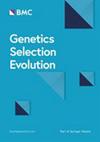The impact of deregressed foreign breeding values on national beef cattle single-step genomic evaluation
IF 3.1
1区 农林科学
Q1 AGRICULTURE, DAIRY & ANIMAL SCIENCE
引用次数: 0
Abstract
In recent years, genetic evaluations in cattle breeding have shifted from purely national evaluations to multinational evaluations considering relatives from other countries. Integrating international estimated breeding values (EBVs) into national genomic evaluations presents challenges due to differences in evaluation methodologies and data sources. This study focused on the impact of blending internationally derived EBVs with national EBVs in the single-step genomic evaluation of German beef cattle using three approaches to deregressing EBVs. The national phenotypic data for four breeds (Angus, Charolais, Limousin, and Simmental) were obtained from the routine German beef cattle evaluation of December 2022, and the international EBVs were obtained from the routine Interbeef evaluation of January 2023. Scalar (Garrick (GA), Van Raden (VR)) and matrix deregression approaches were compared for reversibility of EBVs. A forward validation study was used to evaluate the accuracy, dispersion and level bias obtained in a purely national single-step evaluation, and single-step genomic evaluations blended with DRPs obtained from the three deregression approaches. A validation study based on forward prediction showed improved accuracy, and reduced dispersion bias in the EBVs blended with international EBVs compared to purely national EBVs, particularly for the direct and maternal effects of 200-day weight. As expected, Pearson correlation analysis revealed that the matrix deregression (> 0.99) approach outperformed the scalar deregression approaches (0.75–0.99), exhibiting a greater correlation between the EBVs obtained from DRPs and the EBVs obtained from phenotypes across the various breeds and traits in our study. A forward validation study with and without integrating foreign data across the three deregression methods showed improvement in reducing dispersion bias, as indicated by the regression coefficient. The GEBVs from an evaluation incorporating foreign information with national data showed a higher correlation to the GEBVs from a truncated evaluation than those from an evaluation without foreign information. These findings underscore the importance of accurately integrating foreign EBVs to enhance national genomic evaluations and genetic progress in livestock populations. Our results show that the matrix approach to deregressing EBVs performs optimally across traits and breeds. However, the VR deregression approach can serve as an alternative in situations where the matrix deregression approach might be too technical to implement.解除外源育种价值对国家肉牛单步基因组评估的影响
近年来,牛的遗传评价已从单纯的国家评价转向考虑其他国家亲缘关系的多国评价。由于评估方法和数据来源的差异,将国际估计育种值(ebv)整合到国家基因组评估中存在挑战。本研究的重点是在德国肉牛的单步基因组评估中,使用三种方法去除ebv,将国际衍生ebv与本国ebv混合的影响。4个品种(安格斯、夏洛莱、利穆赞和西蒙塔尔)的全国表型数据来自2022年12月的德国肉牛常规评估,国际ebv数据来自2023年1月的Interbeef常规评估。比较标量(Garrick (GA), Van Raden (VR))和矩阵去回归方法对ebv可逆性的影响。采用前向验证研究来评估纯国家单步评估获得的准确性、离散度和水平偏差,以及单步基因组评估与三种去回归方法获得的DRPs混合。一项基于前向预测的验证研究表明,与纯粹的国内ebv相比,ebv与国际ebv混合的准确性更高,分散偏差减少,特别是对200天体重的直接和母体影响。正如预期的那样,Pearson相关分析显示,矩阵去回归方法(> 0.99)优于标量去回归方法(0.75-0.99),表明在我们的研究中,从DRPs中获得的ebv与从各种品种和性状的表型中获得的ebv之间存在更大的相关性。一项有和没有整合国外数据的前向验证研究表明,三种去回归方法在减少分散偏差方面有所改善,如回归系数所示。与不包含外国信息的评估相比,包含外国信息和国家数据的评估的gebv与截断评估的gebv具有更高的相关性。这些发现强调了准确整合外来ebv对加强国家基因组评估和牲畜种群遗传进展的重要性。我们的研究结果表明,矩阵方法解除ebv在性状和品种中表现最佳。然而,在矩阵解算方法可能过于技术性而无法实现的情况下,VR解算方法可以作为一种替代方案。
本文章由计算机程序翻译,如有差异,请以英文原文为准。
求助全文
约1分钟内获得全文
求助全文
来源期刊

Genetics Selection Evolution
生物-奶制品与动物科学
CiteScore
6.50
自引率
9.80%
发文量
74
审稿时长
1 months
期刊介绍:
Genetics Selection Evolution invites basic, applied and methodological content that will aid the current understanding and the utilization of genetic variability in domestic animal species. Although the focus is on domestic animal species, research on other species is invited if it contributes to the understanding of the use of genetic variability in domestic animals. Genetics Selection Evolution publishes results from all levels of study, from the gene to the quantitative trait, from the individual to the population, the breed or the species. Contributions concerning both the biological approach, from molecular genetics to quantitative genetics, as well as the mathematical approach, from population genetics to statistics, are welcome. Specific areas of interest include but are not limited to: gene and QTL identification, mapping and characterization, analysis of new phenotypes, high-throughput SNP data analysis, functional genomics, cytogenetics, genetic diversity of populations and breeds, genetic evaluation, applied and experimental selection, genomic selection, selection efficiency, and statistical methodology for the genetic analysis of phenotypes with quantitative and mixed inheritance.
 求助内容:
求助内容: 应助结果提醒方式:
应助结果提醒方式:


